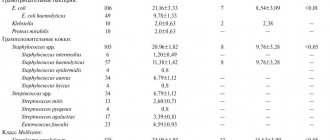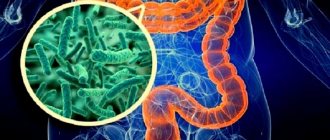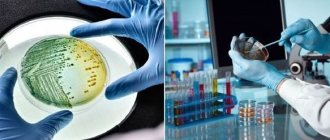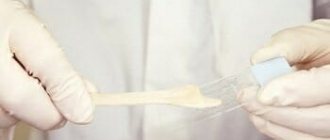Table 1. Qualitative and quantitative composition of the main microflora of the large intestine in healthy people (CFU/g Feces)
(Industry standard 91500.11.0004-2003 “Protocol for the management of patients. Intestinal dysbiosis” - APPROVED by order of the Ministry of Health of Russia dated 06/09/2003 N 231)
| Types of microorganisms | Age, years | ||
| < 1 | 1-60 | > 60 | |
| Bifidobacteria | 1010 — 1011 | 109 — 1010 | 108 – 109 |
| Lactobacilli | 106 — 107 | 107 – 108 | 106 — 107 |
| Bacteroides | 107 – 108 | 109 — 1010 | 1010 — 1011 |
| Enterococci | 105 — 107 | 105 – 108 | 106 – 107 |
| Fusobacteria | < 106 | 108 – 109 | 108 – 109 |
| Eubacteria | 106 — 107 | 109 — 1010 | 109 — 1010 |
| Peptostreptococci | < 105 | 109 — 1010 | 1010 |
| Clostridia | <= 103 | <= 105 | <= 106 |
| Escherichia (E.coli): | |||
| E. coli typical | 107 – 108 | 107 – 108 | 107 – 108 |
| E. coli lactose negative | < 105 | < 105 | < 105 |
| E. coli hemolytic | 0 | 0 | 0 |
| Other opportunistic enterobacteria <*> | < 104 | < 104 | < 104 |
| Staphylococcus aureus | 0 | 0 | 0 |
| Staphylococci (saprophytic, epidermal) | <= 104 | <= 104 | <= 104 |
| Yeast-like fungi of the genus Candida | <= 103 | <= 104 | <= 104 |
| Non-fermenting bacteria <**> | <= 103 | <= 104 | <= 104 |
<*> - representatives of the genera Klebsiella, Enterobacter, Hafnia, Serratia, Proteus, Morganella, Providecia,
Citrobacter etc.
<**> - Pseudomonas, Acinetobacter, etc.
The microorganisms listed in the dysbacteriosis analysis form can be divided into three groups:
- lactic acid bacteria of normal microflora - mainly bifidobacteria and lactobacilli,
- pathogenic enterobacteria,
- opportunistic pathogenic flora (OPF).
Lactic acid bacteria
The basis of the normal intestinal microflora is lactic acid bacteria - bifidobacteria, lactobacilli and propionic acid bacteria with a predominance of bifidobacteria, which play a key role in maintaining the optimal composition of the biocenosis and its functions. A drop in the number of bifidobacteria and lactobacilli below normal indicates the presence of problems in the body. At a minimum, this is inflammation on the mucous membranes and a decrease in immune defense.
Pathogenic enterobacteria
Pathogenic enterobacteria are bacteria that can cause acute intestinal infections (the causative agents of typhoid fever are Salmonella, the causative agents of dysentery are Shigella, the causative agents of yersiniosis are Yersinia, etc.). Their presence in feces is no longer just dysbacteriosis, but an indicator of a dangerous infectious intestinal disease.
Opportunistic pathogenic flora (OPF)
Opportunistic flora includes lactose-negative enterobacteria, clostridia, various cocci, etc. The essence of these microbes is reflected in the name of the group: “opportunistic”. Normally they do not cause any problems. Many of them can even be beneficial to the body to a certain extent. But if the norm is exceeded and/or the immune defense is ineffective, they can cause serious diseases. By competing with beneficial bacteria, opportunistic flora can become part of the intestinal microbial film and cause functional disorders, inflammatory and allergic diseases.
It is possible for opportunistic flora to enter the blood through the intestinal wall and spread throughout the body (translocation), which is especially dangerous for young children and people with severe immunodeficiencies, in whom these microorganisms can cause various diseases, including life-threatening ones.
Explanations for the table
Typically, the number of detected bacteria in the analysis form is indicated by the number 10 to some degree: 103, 105, 106, etc. and the abbreviation CFU/g, which means the number of living bacteria capable of growing in 1 g of feces.
The abbreviation “abs” next to the name of the bacterium means that this microorganism was not found within the normal range or above it, and values below the norm (subnormal) were not considered as insignificant.
Bifidobacteria
Bifidobacteria are the basis of the normal microflora of the large intestine. Normally, their content in the intestines should be 1010-1011 in children under one year old, and 109-1010 CFU/g in adults. A noticeable decrease in the number of bifidobacteria is the main sign of the presence of dysbiosis and immune disorders.
Deficiency of bifidobacteria leads to increased intoxication, disruption of carbohydrate metabolism, absorption and assimilation of vitamins, calcium, iron and other micro- and macroelements in the intestines. Without a biofilm of bifidobacteria, the structure of the intestinal mucosa changes and the functions of the intestinal mucosa are disrupted, the number of immune cells and their activity decreases, and intestinal permeability to foreign agents (toxins, harmful microbes, etc.) increases. As a result, the toxic load on the liver and kidneys significantly increases, the risk of developing infections and inflammations, vitamin deficiencies and various microelementoses increases.
Lactobacilli
Lactobacilli, as well as bifidobacteria, are one of the main components of normal human microflora. The normal content in the intestines of children under one year of age is 106 - 107, in adults - 107-108 CFU/g. A significant decrease in the number of lactobacilli indicates not only dysbiotic disorders, but also that the body is in a state of chronic stress, as well as a decrease in antiviral and antiallergic protection, disorders of lipid metabolism, histamine metabolism, etc. Lactobacillus deficiency greatly increases the risk of developing allergic reactions, atherosclerosis, neurological disorders, cardiovascular diseases, can also cause constipation and the development of lactase deficiency.
Bacteroides
Bacteroides are opportunistic bacteria. The second largest group (after bifidobacteria) of intestinal microorganisms, especially in adults (the norm is up to 1010 CFU/g), in children under one year of age - 107-108. When kept within normal limits, they perform many beneficial functions for the body. But if the balance in the intestinal microcenosis is disturbed or if the norm is exceeded, bacteroids can lead to a variety of infectious and septic complications. With excessive growth, bacteroids can suppress the growth of E. coli by competing with it for oxygen. The uncontrolled growth of bacteroids and their manifestation of aggressive properties limit the main components of the protective flora - bifidobacteria, lactobacilli and propionic acid bacteria.
Enterococci
Enterococci are the most common opportunistic microorganisms found in the intestines of healthy people. The content norm for children under one year is 105-107, for adults – 105-108 (up to 25% of the total number of coccal forms). Some experts consider them harmless. In fact, many enterococci are capable of causing inflammatory diseases of the intestines, kidneys, bladder, reproductive organs, not only when they exceed the permissible amount (with a content of more than 107), but also in an amount corresponding to the upper limit of normal (106-107), especially in humans with reduced immunity.
Fusobacteria
Fusobacteria are opportunistic bacteria, the main habitats of which in the human body are the large intestine and the respiratory tract. The oral cavity of an adult contains 102-104 CFU/g of fusobacteria. The permissible amount in the intestines in children under one year of age is < 106, in adults - 108 - 109.
Some types of fusobacteria in immunodeficiencies can cause secondary gangrenous and purulent-gangrenous processes. With tonsillitis, herpetic stomatitis, malnutrition in children, and immunodeficiency states, the development of fusospirochetosis is possible - a necrotic inflammatory process on the tonsils and oral mucosa.
Eubacteria (lat. Eubacterium)
They belong to the main resident microflora of both the small and large intestines of humans and make up a significant part of all microorganisms inhabiting the gastrointestinal tract. The permissible amount of eubacteria in the stool of healthy people: in children of the first year - 106-107 CFU/g; in children over one year old and adults, including the elderly - 109-1010 CFU/g.
Approximately half of the species of eubacteria living in the human body can participate in the development of inflammation of the oral cavity, the formation of purulent processes in the pleura and lungs, infective endocarditis, arthritis, infections of the genitourinary system, bacterial vaginosis, sepsis, abscesses of the brain and rectum, and postoperative complications.
An increased content of eubacteria is found in the feces of patients with colon polyposis. Eubacteria are rarely found in breastfed children, but in bottle-fed children they can be detected in quantities corresponding to the norm for an adult.
Peptostreptococci
Peptostreptococci belong to the normal human microflora. The normal content in feces in children under one year of age is <105, in children over one year of age and adults - 109 - 1010. In the body of a healthy person, peptostreptococci live in the intestines (mainly in the colon), oral cavity, vagina, and respiratory tract. Typically, peptostreptococci are causative agents of mixed infections, manifesting themselves in associations with other microorganisms.
Clostridia
Opportunistic bacteria, representatives of putrefactive and gas-forming flora, the number of which depends on the state of local intestinal immunity. The main habitat in the human body is the large intestine. The permissible amount of clostridia in children under one year of age is no more than 103, and in adults - up to 105 CFU/mg.
In combination with other opportunistic flora, clostridia can cause stool liquefaction, diarrhea, and increased gas formation, which, along with the rotten smell of feces (symptoms of putrefactive dyspepsia), is an indirect sign of increased numbers and activity of these bacteria. Under certain conditions, they can cause necrotic enteritis and cause foodborne illness, accompanied by watery diarrhea, nausea, abdominal cramps, and sometimes fever.
When taken with certain antibiotics, clostridia can cause antibiotic-associated diarrhea or pseudomembranous colitis. In addition to intestinal problems, clostridia can cause diseases of the human genitourinary organs, in particular acute prostatitis. The symptoms of inflammation caused by clostridia in the vagina are similar to the symptoms of candidal vaginitis (“thrush”).
E.coli typical (Eschechiria, E. coli typical) , i.e. with normal enzymatic activity
Opportunistic microorganisms, which, together with bifidobacteria and lactobacilli, belong to the group of protective intestinal microflora. This bacillus prevents the colonization of the intestinal wall by foreign microorganisms, creates comfortable conditions for other important intestinal bacteria, for example, absorbs oxygen, which is a poison for bifidobacteria. This is the main “vitamin factory” in the body.
Normally, the total content of E. coli is 107-108 CFU/mg (which corresponds to 300-400 million/g). Elevated levels of E. coli in the intestines can cause inflammation, accompanied by stool problems and abdominal pain. And its penetration from the intestines into other ecological niches of the body (urinary tract, nasopharynx, etc.) is the cause of cystitis, kidney diseases, etc.
A decrease in this indicator is a signal of a high level of intoxication in the body. A strong decrease in the number of typical E. coli (up to 105 CFU/mg and below) is an indirect sign of the presence of parasites (for example, worms or parasitic protozoa - Giardia, blastocysts, amoebas, etc.). In addition to parasites, among the most likely reasons for a decrease in E. coli levels are the existence of foci of chronic infection in the body, increased allergization, dysfunction or diseases of various organs, primarily the liver, kidneys, pancreas and thyroid glands. To avoid misdiagnosis and, accordingly, incorrect treatment, it is recommended to first exclude parasitic infection.
Escherichia coli with reduced enzymatic activity (E.coli lactose-negative).
The content rate is no more than 105 CFU/g. This is an inferior variety of E. coli, which usually does not pose a direct danger. But this stick is a parasite. It takes the place of full-fledged E.coli, without performing the beneficial functions inherent in full-fledged E.coli. As a result, the body does not receive enough vitamins, enzymes and other beneficial substances synthesized by full-fledged Escherichia, which ultimately can lead to serious metabolic disorders and even inflammatory diseases. The presence of this bacillus in quantities above the permissible norm is always a sign of incipient dysbiosis and, along with a decrease in the total amount of E. coli, can be an indirect indicator of the presence of parasitic protozoa or worms in the intestines.
E. coli hemolytic (hemolytic Escherichia coli)
Pathogenic variant of Escherichia coli. Normally it should be absent. Its presence requires immunocorrection. May cause allergic reactions and various intestinal problems, especially in young children and those with weakened immune systems. It often forms pathogenic associations with Staphylococcus aureus, but unlike it, it is practically not found in breast milk.
Other opportunistic enterobacteriaceae
(Proteus, Serration, Enerobacter, Klebsiella, Hafnia, Citrobacter, Morganella, etc.) A large group of lactose-negative enterobacteria of greater or lesser degree of pathogenicity. The permissible number of these microorganisms is less than 104 CFU/g. A larger number of these bacteria is a sign of dysbiosis. A significant excess of the norm (more than 106) can lead to inflammatory diseases of the intestines (manifested by stool disorders, pain), urogenital diseases and even ENT organs, especially in young children and people with reduced immunity.
The most unpleasant bacteria of this group:
- Proteas - constipation is most often associated with them, but they can also cause acute intestinal infections, diseases of the urinary tract and human kidneys, in particular acute and chronic prostatitis, cystitis, pyelonephritis.
- Klebsiella are direct antagonists (competitors) of lactobacilli, leading to the development of allergies, constipation, and manifestations of lactase deficiency. An indirect sign of the excessive presence of Klebsiella is green stool with mucus, a sour smell of feces (symptoms of fermentative dyspepsia).
Staphylococcus aureus (S. aureus)
One of the most unpleasant representatives of opportunistic flora. Normally it should be absent, especially in children. For adults, the permissible content is 103 CFU/g.
Even small amounts of Staphylococcus aureus can cause pronounced clinical manifestations (allergic reactions, pustular skin rashes, intestinal dysfunction), especially in children in the first months of life. In addition to the intestines and skin, staphylococci live in considerable quantities on the mucous membranes of the nose and can cause inflammatory diseases of the nasopharynx and otitis media.
The main conditions on which the degree of pathogenicity of staphylococci and the body’s susceptibility to them depend are the activity of the body’s immune defense, as well as the number and activity of bifidobacteria and lactobacilli competing with staphylococcus, which are able to neutralize its harmfulness. The more strong, active bifidobacteria and lactobacilli in the body, the less harm from staphylococcus (there may be no clinical manifestations, even if its number has reached 105 CFU/g). The greater the deficiency of bifidobacteria and lactobacilli and the weaker the body’s immune defense, the more active the staphylococcus.
Those with a sweet tooth and people with weak immune systems are at risk. First of all, these are children - premature babies, born as a result of a problematic pregnancy, cesarean section, deprived of natural breastfeeding, and those who have undergone antibiotic therapy. Staphylococci can enter a child's body through mother's milk, from the mother's mucous membranes and skin (close contact).
Staphylococci saprophytic, epidermal (S. epidermidis, S. saprophyticus)
Refers to opportunistic microflora. When normal values are exceeded (104 CFU/g or 25% of the total number of cocci), these staphylococci can cause certain disorders. As a rule, they act as a secondary infection. In addition to the intestines, they live in the upper layers of the skin, on the mucous membranes of the mouth, nose and outer ear. The pathogenicity of the microorganism increases with a significant decrease in the body's defenses, with long-term chronic diseases, stress, hypothermia, and immunodeficiency states.
Yeast-like fungi of the genus Candida
The maximum permissible amount is up to 104. Exceeding this level indicates a decrease in the body’s immune defense and a very low pH in the candida habitat, and may also be a consequence of the use of antibiotics and a large amount of carbohydrates in the diet. With an increased number of these fungi against the background of a decrease in the amount of normal flora, symptoms of candidiasis, more often called thrush, may appear on the mucous membranes of the mouth and genitals. Infection with intestinal fungi against the background of a deficiency of the main groups of intestinal bacteria indicates systemic candidiasis, dysfunctional immunity and an increased risk of developing diabetes.
Non-fermenting bacteria (listed as "Other microorganisms" on some forms)
Pseudomonas, Acinetobacter and other types of bacteria rarely found in the human intestine, the most dangerous of which is Pseudomonas aerugenosa. The maximum permissible amount in adults is no more than 104. As a rule, their detection in quantities above the norm requires antibacterial therapy and immunocorrection.
Preparation and rules for collecting material
Strict adherence to the rules for preparing and taking samples of biomaterial is the key to the reliability of the result. To carry out the procedure, you must prepare the necessary container in advance - a pot or a duck. Wash thoroughly without using chemical detergents. Treat with medical alcohol and rinse with boiling water. Before defecation, perform hygiene of the anal area.
- For analysis of dysbacteriosis, stool obtained naturally without the use of laxatives and enemas is selected. Taking carrier medications and using medicinal suppositories should be stopped 3-4 days before submitting the material for research.
- 72 hours before the procedure, avoid drinking alcohol, meat, fish, and foods that color feces, change the smell and consistency. For example, beets, kiwi, blueberries, strong coffee.
- For 2-3 days, do not take medications that affect intestinal motility and accelerate the removal of food from the stomach.
- Women are not recommended to take a stool test for dysbiosis during menstruation.
- Collect the biomaterial in a sterile pharmaceutical container, tightly closed with a lid. Deliver to the laboratory within 4-8 hours. Do not freeze!
A sample taken earlier than 4 days after intestinal endoscopy or stomach radiography using contrast enhancers is considered unsuitable for research.
The most popular question, how to take 10-15 g of feces into a container, can be solved very simply. In order not to struggle with cotton swabs, matches and toothpicks, the easiest way is to use a plastic teaspoon.








